
In the bustling environment of a classroom, creating a serene and inviting reading nook can significantly impact children’s learning and love for reading. A dedicated reading nook in the kids’ classroom or class library serves as a sanctuary where imaginations flourish and literacy skills are nurtured. This space not only encourages independent reading but also fosters a sense of calm and focus amidst the school day’s chaos. By integrating cozy seating, accessible book displays, and thematic decorations, educators can craft an area that students are drawn to. The importance of such a space cannot be overstated, as it supports emotional well-being, enhances concentration, and promotes a lifelong passion for reading. Let’s explore how to create the perfect reading nook that combines functionality with whimsy to captivate young minds.
Designing the Perfect Reading Nook for Kids Classroom
Creating an inviting reading nook in the kids classroom starts with understanding the space and the needs of the students. Opt for soft, comfortable seating like bean bags, cushions, or small chairs that accommodate various age groups. Ensure the area is well-lit, preferably with natural light, to create a warm and welcoming atmosphere. Incorporate low bookshelves or bins that allow children easy access to books, encouraging independence. Thematic decorations, such as a starry sky or under-the-sea theme, can spark imagination and make the nook more appealing. Remember, the goal is to create a space where children feel comfortable and excited to explore the world of books.
Essential Elements of a Class Library Reading Nook
A class library reading nook should be a blend of functionality and creativity. Start with a diverse collection of books that cater to different reading levels and interests. Organize books in a way that makes selection easy, perhaps by genre or reading level. Include a variety of seating options to accommodate different preferences and needs. Adding a small table or desk can provide a space for writing or drawing inspired by their reading. Personal touches, like student-made bookmarks or a 'book of the week' display, can make the space feel more personal and engaging. The key is to create a dynamic space that evolves with the students' interests and needs.
Engaging Activities for the Kids Classroom Reading Nook
To maximize the potential of the reading nook in the kids classroom, integrate activities that complement reading. Consider setting up a reading challenge with rewards to motivate students. Storytelling sessions or book discussions can foster a sense of community and shared learning. Incorporate technology with audiobooks or e-readers for a modern twist. Seasonal themes or book-related crafts can keep the space fresh and exciting. Encouraging students to contribute ideas for the nook can give them a sense of ownership and pride in their reading space. The possibilities are endless when it comes to making the reading nook a central part of the classroom's learning environment.
Conclusion
A reading nook in the kids classroom or class library is more than just a quiet corner; it's a gateway to new worlds, ideas, and adventures. By thoughtfully designing this space, educators can significantly enhance students' reading experiences and literacy skills. The key lies in creating an area that is accessible, comfortable, and stimulating, tailored to the children's interests and needs. As we look to the future, the importance of fostering a love for reading from an early age cannot be underestimated. Let's commit to transforming our classrooms into havens of learning and imagination, one reading nook at a time. For more inspiration on creating engaging learning spaces, visit https://wheelsofflavor.com/.
Frequently Asked Questions
Q: How can I make a reading nook in a small classroom?
Even in a small classroom, you can create an effective reading nook by utilizing vertical space with wall-mounted bookshelves and choosing compact, multi-functional furniture. Foldable or stackable seating can save space when not in use. A corner of the room can be transformed with a cozy rug and some cushions, making it a perfect spot for reading without requiring much space.
Q: What types of books should I include in a class library reading nook?
A class library reading nook should include a wide range of books to cater to different interests and reading levels. Picture books, early readers, chapter books, and non-fiction titles should all have a place. Consider including books that reflect diverse cultures, experiences, and perspectives to foster inclusivity and broaden students' horizons.
Q: How often should I update the reading nook to keep students engaged?
Refreshing the reading nook every few months can keep students interested. Introduce new books regularly, rotate themes based on seasons or curriculum topics, and incorporate student feedback to make the space more engaging. Small changes, like new decorations or seating arrangements, can also make the nook feel new and exciting without a complete overhaul.

